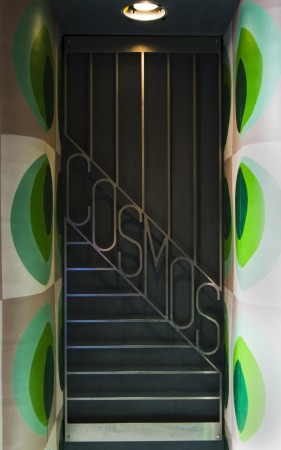19 October to 25 November 2017

We paint to conceal, to protect, to decorate. Walls and doors; signs and sets; chairs and figurines; smiles and fingernails. The Glass Ticker engages the vernacular of paint and display beyond the constraints of fine art. Here, Sandra Meigs uses paint to form worlds rather than represent them.
At the exhibition’s whirling centre is Cosmos—a spectacular art deco storefront, constructed at one-half scale. Its exterior presents painted emerald planets by the dozen and twinned, snappily dressed, carrot-haired boys. In sync, their animatronic fingers tick against glass. Come here! Come in! Welcome! However, within their miniaturized set, the boys’ diminutive statures appear larger-than-life. Like half-faded dreams or the experience of revisiting a former home, perception slips against memory. The known brushes against the unknown.
Following Freud’s 1919 essay Das Unheimliche and Masahiro Mori’s description of the Uncanny Valley, a multitude of research essays and memes have examined the point at which the familiar slides into something less comforting. Imagine: a scale that measures discomfort by way of humanoid robots, the Olson sisters, zombies, prosthetic hands, and Keanu Reeves. Twins often feature on these graphs because they represent concentrated familiarity. As such, they have come to symbolize gatekeepers for a world askew. One is more the other than the other. The other is more them than itself. A reflection, an echo, the egg divided in two, and then divided again. With their mirrored animatronic bodies, Meigs’ twins offer a doubled uncanny. Ticking in time – tick him – tick me – tick them – tick us – their plurality suggests the possibility of physical interchangeability. They compel us past individual experience towards a new world, a new order of existence, a new cosmos that encompasses boundless possibility.

